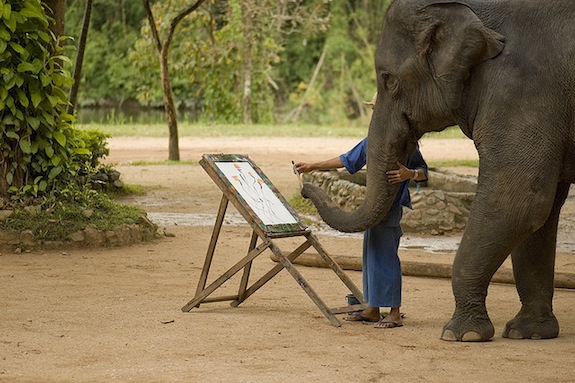Why Do We Care Whether Animals Appreciate Our Art?
In a recent study, researchers put seven Java Sparrows in a cage with a bunch of artwork and watched them to see which ones they preferred

Image: Paul Esson
One of the things that’s often presented as uniquely human is art. We have Picasso, Monet, Banksy and Michelangelo. Animals do not. And yet, curiously, we seem to be obsessed with understanding whether or not animals can make and understand art.
Take this recent study on Java Sparrows. The researchers put seven birds in a cage with a bunch of artwork and watched them to see which ones they preferred. They found that the birds did seem to have an opinion about the art:
The researchers observed that five of the seven birds perched in front of the cubist paintings longer than they did the impressionist paintings. Three Java sparrows preferred Japanese-style to cubist paintings, but another two preferred cubist to Japanese-style paintings. Between Japanese-style paintings and impressionist paintings (said to be influenced by Japanese-style painting), six of the seven sparrows showed no clear preference for either.
There are more studies with birds too. Pigeons were trained to distinguish between Picasso and Monet and between “good” and “bad” art. There are questions about whether or not the nests of bowerbirds are art. There are elephants that paint and armadillos that create Jackson Pollock–like work.
And we’re not only interested in animals’ relationship to visual art, either. This 2001 study is actually titled “Music discriminations by carp” and tested to see whether they could tell the difference between John Lee Hooker and Bach. Primates tend to dislike more music in general, but if they have to pick, they like slower tempos.
But why are we humans so interested in whether or not animals can make and appreciate our art? Some of these studies have to do with conditioning and training. Understanding just what you can teach a bird to discriminate between, and can tell us about how well they see, how they perceive the world, and how powerful their brains are.
But there might be other reasons we’re so interested in animal art too. Wired argues that if animals can make art, that challenges our own human creativity:
Art is usually considered a uniquely human ability, but that may not be true. Given the opportunity, animals like chimpanzees and gorillas and elephants produce abstract designs that arguably rise to artistic level.
Arguably is, however, the key word. It’s hard enough to agree on an essential definition of human art, much less an animal one.
Does it matter whether animals have an aesthetic sense or may be motivated to create art? And if animals do have an aesthetic sense and produce art, are there any implications for research, for our scientific theories, or for the way we treat them? Because scientists have traditionally assumed that the ability to create and enjoy art does not exist in animals, researchers still know next to nothing about what such an ability might be like. But we would answer all of these questions with a cautious yes.
And if the answer is yes, what does that mean? Does the fact that carp can tell the difference between Bach and John Lee Hooker challenge our human understanding and appreciation of music? Does it mean that humans aren’t as special as we once thought—as we have had to realize many, many times over the course of history? Or is it just a nice parlor trick?
Many of these are questions that science can’t really answer. They can tell us that Java Sparrows will sit in front of cubist paintings more than often than impressionism, but they can’t really tell us what that means or why we’re so obsessed with knowing it.
More from Smithsonian.com:
“Artful Animals” Opens at National Museum of African Art
Cavemen Were Much Better At Illustrating Animals Than Artists Today
/https://tf-cmsv2-smithsonianmag-media.s3.amazonaws.com/accounts/headshot/Rose-Eveleth-240.jpg)
/https://tf-cmsv2-smithsonianmag-media.s3.amazonaws.com/accounts/headshot/Rose-Eveleth-240.jpg)